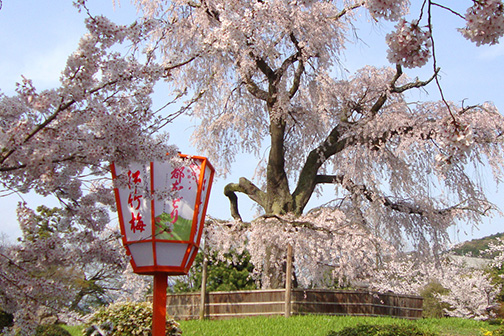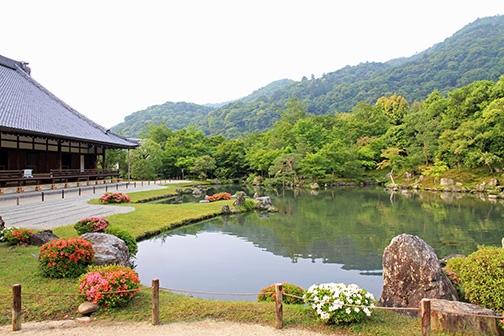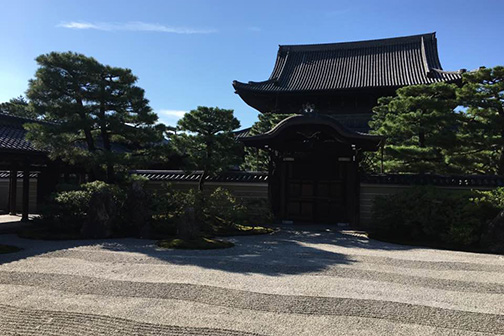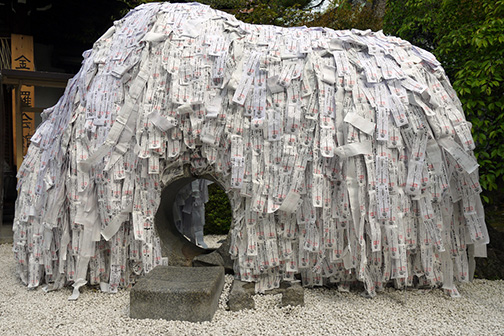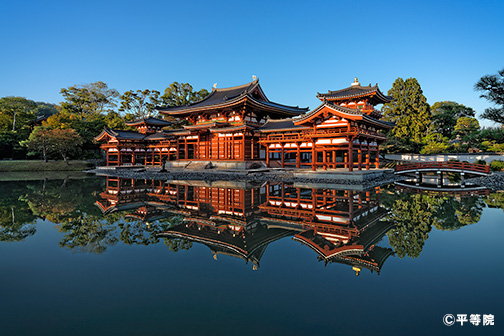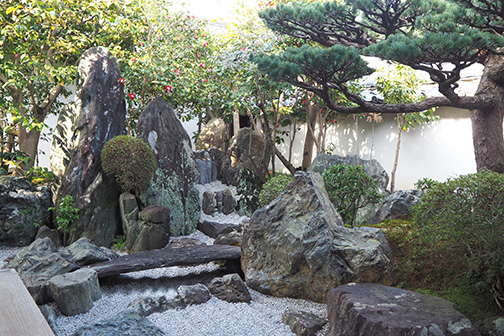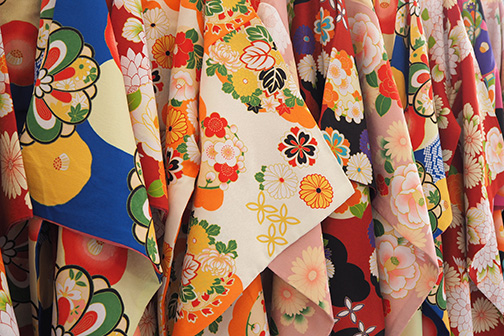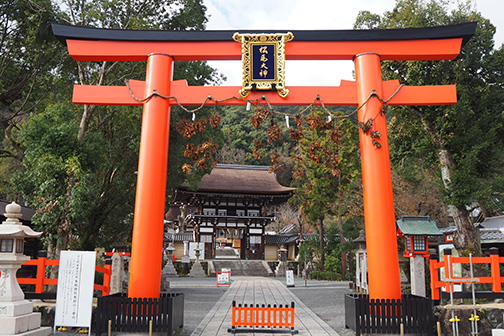
Timeless Kyoto
Explore Kyoto: Tours and Itineraries
栬 -Autumn Colors-
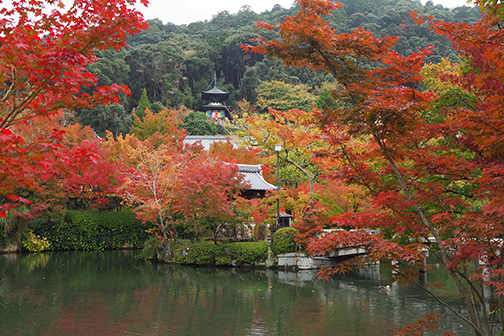 Eikan-do
Eikan-do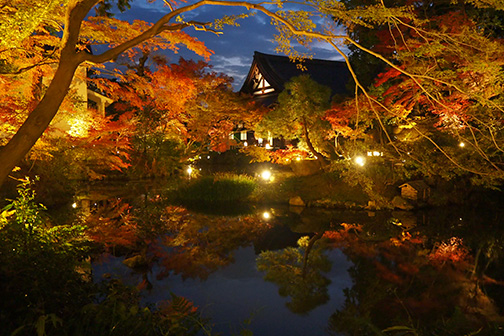 Konkai komyo-ji Temple
Konkai komyo-ji Temple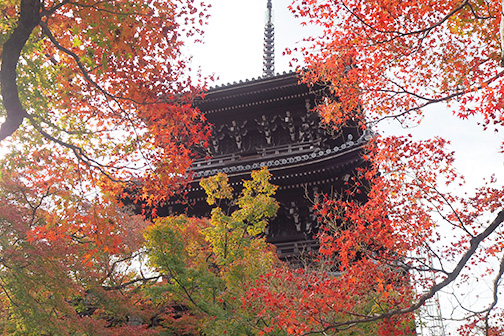 Shinnyo-do
Shinnyo-doKyoto
Anraku-ji Temple
Anraku-ji Temple is one of the most photographed sights during the fall foliage season and for good reason. The maple-lined approach and thatched-roof entry gate are incredibly picturesque. Once inside, the garden offers more delights, and the image of the Amida Buddha in the main hall is sublime.
Eikan-do (Eikan Hall)
Perhaps Kyoto’s most famous (and most crowded) autumn-foliage destination, Eikan-do is a superb temple just a short walk south of the famous Path of Philosophy. Eikan-do features varied architecture, gardens and works of art. It was founded as Zenrin-ji Temple in 853 by the priest Shinsho.
Konkai Komyo-ji Temple
Founded in 1175, Konkai Komyo-ji Temple is one of eight head temples of the Jodo (Pure Land) sect, a major Buddhist denomination. This temple is a must-see for history lovers. In the long history of Japan, the end of the Edo Period (in the 1860s) is popular among history buffs. Revolutionaries fought with those who were intent on maintaining the Tokugawa regime. Kyoto was the battleground of many heated conflicts, and Konkai Komyo-ji Temple became the birthplace of a legendary group called the Shinsengumi that worked to ensure security. The temple is also famous for its wonderful autumn scenery.
Shinnyo-do
Shinnyo-do is a temple of the Tendai sect established in 984 by a priest from the influential Enryaku-ji Temple. Off the beaten track of Kyoto, Shinnyo-do is a beautiful spot to see the autumn colors. The lovely fall colors usually peak around late November, and the temple is usually less crowded than other spots.
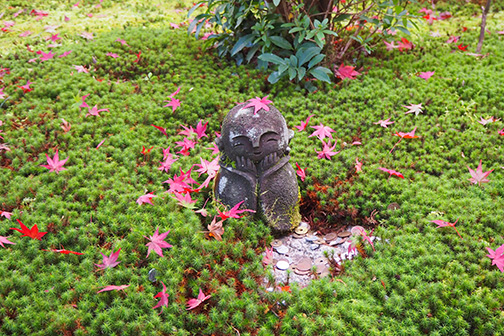 Enko-ji Temple
Enko-ji Temple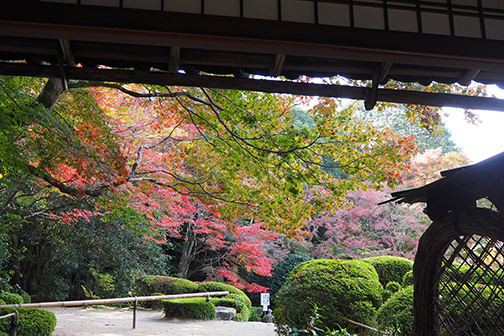 Shisen-do Temple
Shisen-do Temple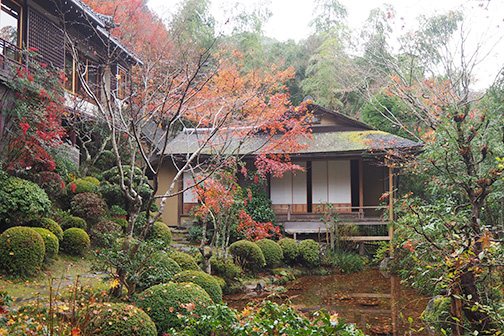 Jakko-in Temple
Jakko-in TempleKyoto
Enko-ji Temple
The temple was founded in 1601 by the first shogun of the Edo Period, Tokugawa Ieyasu. It was originally opened for use as a public school. Enko-ji Temple has a beautiful Zen garden with a pond and is enjoyable year round, but the best time to visit is during fall for the splendid autumn foliage, which can be viewed from the main hall of the temple. The temple site also has a stone garden and a stunning bamboo grove.
Shisen-do Temple
Shisen-do Temple was originally built as the villa of the retired samurai Jozan Ishikawa (1583–1672). The garden in front of the Shoin building is in the ancient Chinese style with beautifully landscaped azalea shrubs. The garden offers different attractions in each season but the autumn leaves make for an incredible sight in fall. Visitors can experience a special water feature using bamboo invented by Jozan himself. The bamboo makes a charming clacking sound designed to scare away deer and wild boar from farmers’ fields.
Experience Shakyo (Sutra Copying) at Sanzen-in Temple
Sanzen-in Temple was founded by the monk Saicho in the late eighth century. The temple was moved to its present site in the latter half of the 15th century when Kyoto was devastated by wars. Historically, many generations of the Imperial family have served as the heads of the temple. The temple is widely known for its lovely display of hydrangeas in early summer and maple trees in autumn. Shakyo (copying sutras) is considered a form of writing meditation, as the practitioner aligns their body and mind with the sutras they write out. It is considered a meritorious practice, dating back to the time before the printing press when the only way to pass on knowledge was copying texts by hand.
Jakko-in Temple
Nestled in the rural village of Ohara in the northeastern mountains of Kyoto, Jakko-in Temple is known for its gardens, which are particularly lovely in autumn. Jakko-in has been a convent since 1186 and is associated with the legendary feud between the rival Taira (Heike) and Minamoto (Genji) clans in the Heian Period (794–1185). On the hill below the temple is a teahouse built in 1931 with materials from the Imperial family. The materials were from the enthronement ceremony of the Emperor Hirohito at Kyoto Imperial Palace.
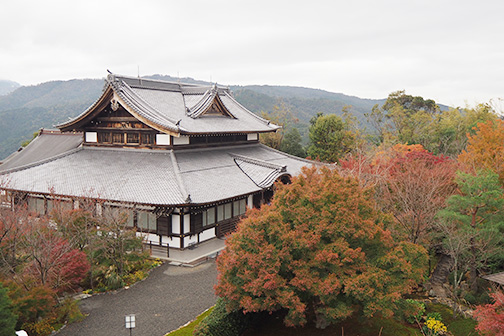 Shogunzuka Mound and Seiryuden
Shogunzuka Mound and Seiryuden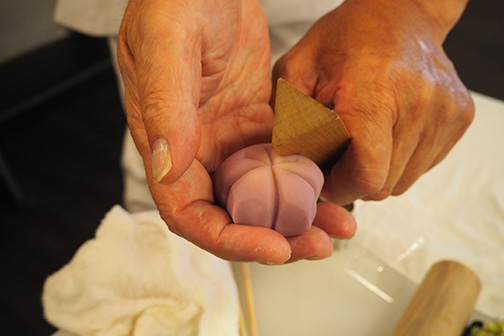 Wagashi Experience
Wagashi ExperienceKyoto
Bishamon-do Temple
The Bishamon-do Temple garden originates from the Edo Period (1603–1868) and was designed around a small central pond with a stone footbridge known as the “bridge to paradise.” Beyond this is a small Shinto shrine that adds to the restful, ethereal charm of the garden. This is especially true in autumn when the shrine’s vermillion woodwork complements the colors of the surrounding trees and fallen leaves. There is also a second garden featuring a larger pond, a stone pagoda and a mausoleum.
Shogunzuka Mound and Seiryuden
Located in the eastern mountains of Kyoto, the Shogunzuka Mound is perhaps best known these days for its observation decks, which offer spectacular views of the city below. The area is part of Shoren-in Temple, whose main buildings stand at the base of the mountain.
Making Wagashi (Japanese traditional sweets) Experience
Unlike many Western desserts, wagashi (traditional Japanese sweets) are designed to be little works of art. Often served with matcha green tea, the shapes and colors of the sweets reflect the season. Try your own hand at forming these elegant sweets.
Kiyomizuyaki Pottery
Kiyomizuyaki, or Kiyomizu ware, is pottery that was historically made at the foot of the famous Kiyomizu Temple. Now the name is generally used for all pottery made in Kyoto. The official name “Kyo ware/Kiyomizu ware” is designated as a Traditional Craft of Japan by the Minister of Economy, Trade and Industry.
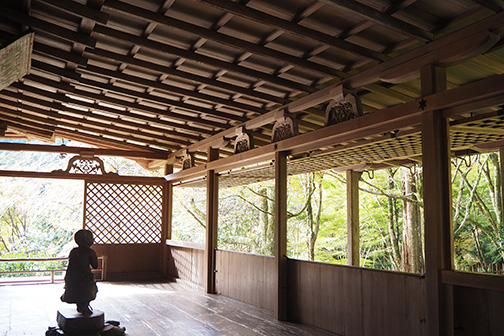 Kozan-ji Temple
Kozan-ji Temple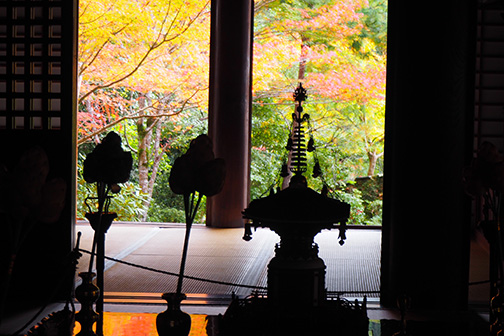 Saimyo-ji Temple
Saimyo-ji Temple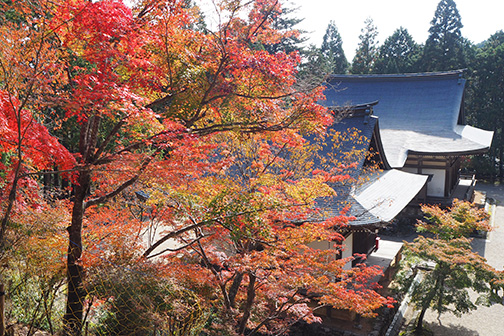 Jingo-ji Temple
Jingo-ji TempleKyoto
Kozan-ji Temple
Kozan-ji Temple is located in a peaceful mountain valley in the Takao area. It is a one of three temples in the valley and designated a UNESCO World Cultural Heritage Site. It is famous for its four-painted scrolls from the Heian Period (794–1185), which are said to be the first manga (comics) in Japan, and its tea field, which is considered the oldest tea field in Japan.
Saimyo-ji Temple
The vermilion Shigetsukyo Bridge, which leads visitors over a river to the temple entrance, is a particularly well-known sight. Saimyo-ji Temple was founded between 824 and 834 by Chisen Daitoku, a leading disciple of Kukai (Kobo Daishi). Along with Jingo-ji Temple and Kozan-ji Temple (a World Heritage Site), this temple is one of the “three most famous temples in northwest Kyoto.” Saimyo-ji Temple is perhaps the smallest of the three temples, but its size belies its charm. Its tiny pond and moss-covered gardens, combined with an amazing view of the valley, are a treat for the eyes.
Jingo-ji Temple
Jingo-ji Temple is the most visited among Takao’s temples. A long set of stone stairs make for an impressive if tiring approach. The temple grounds feature a large entrance gate and multiple halls, as well as a path to an observation point with views over the valley. Small clay discs with inscriptions can be purchased there to be thrown into the valley for good luck.
Food Culture Experience
In the Japanese kitchen, when it comes to stewing, simmering, soups and nabe (hot pot), the one indispensable ingredient is dashi. This all important soup stock is at the heart of Japanese cuisine, lending subtle depth to a wide range of dishes. Dashi is key to making delicious food that’s also good for you. You can learn how to make dashi and then make udon noodles with your dashi.
Genko-an Temple
Genko-an Temple is synonymous with samurai honor and tragedy, and famous for its “windows of wisdom.” The view through the windows highlights the beauty of the autumn leaves. Genko-an was originally built in 1346 as a hermitage for the second chief abbot of Daitoku-ji Temple. The so-called “bloody ceiling” of the main hall was made using floorboards from the disassembled Fushimi Castle, which in 1600 was besieged by enemies of the soon-to-be shogun, Tokugawa Ieyasu. The samurai managed to hold off the enemy before the Battle of Sekigahara, where Tokugawa Ieyasu was victorious and consolidated power over all of Japan.
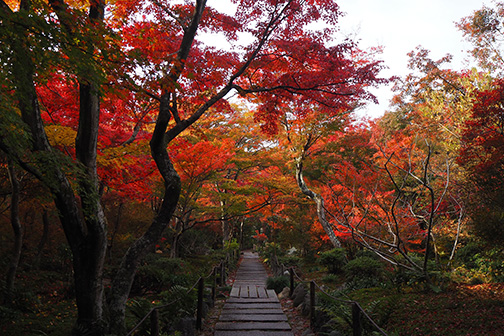 Gio-ji Temple
Gio-ji Temple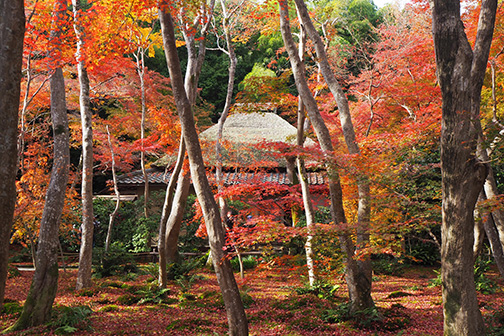 Hokyo-in Temple
Hokyo-in TempleKyoto
Gio-ji Temple
Gio-ji Temple is a quiet temple surrounded by trees and a luxuriant moss garden. The trees are quite dense, and the temple is often covered in deep shade. The temple grounds are especially beautiful in autumn, when the leaves change colors and stand out in sharp contrast to the green moss.
Hokyo-in Temple
Hokyo-in Temple was built back in the 11th century, during the Heian Period, at the order of Emperor Shirakawa. During fall, Hokyo-in Temple is considered to be an off-the-beaten-path viewing spot for maple trees by people “in the know.”
Bamboo Craft Making Experience
With thick, shrine-filled bamboo forests surrounding Kyoto, it is little wonder that bamboo is an integral part of Kyoto craft traditions. Learn how to braid bamboo strips and take home your new creation.
Togetsukyo Bridge
Togetsukyo Bridge is the symbol of Mt. Arashiyama, whose fall foliage puts on a wonderful performance in Kyoto. Built in the Kamakura Period (1185–1333), the bridge received its name, which means “moon crossing,” by Emperor Kameyama during a boating party under a full moon, because he thought the moon looked like it was crossing the bridge. It spans 155 m (500 ft) over the Katsura River.

